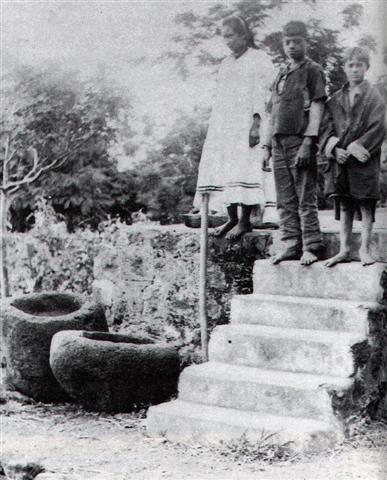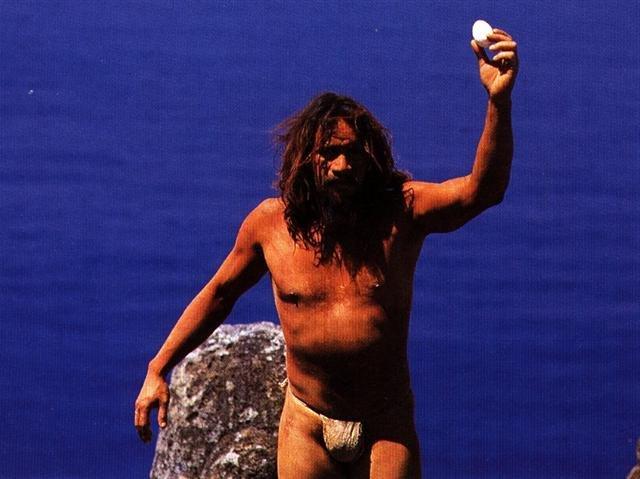24. The toromiro trees needed sweet water to grow and a reliable source was Rano Kau - although otherwise sweet water supplies were scarce. The precious rain drops were stored in stone basins (taheta):
Tupu te toromiro kua noho te vai - (such) toromiro trees who are living - kua noho - (in) sweet water, te vai, are thriving, kua tupu:
From Rigel (β Orionis) and Capella (α Aurigae) close to the Full Moon to Rigel and Capella at the Sun in Ca10-6 there were *261 - *78 = 183 days. 9 * 29 (Full Moon) - 13 * 6 (Sun) = 183.
The creator of the C text has with a little dot at the rakau toromiro pointed out the significance of this glyph. A year to be counted from Rigel / Capella could anciently have begun in APRIL 4 (= 10 days after the Julian equinox).
To make a king (haka-ariki) in OCTOBER 1 could have meant creating someone whose task it was to suck up all the waters from the rainy season, i.e. it should be a king in early summer. OCTOBER 1 was when north of the equator the Sun was leaving for his voyage southwards in order to create summer on Easter Island.
... The hot rays of the morning (spring) sun made all water puddles on the ground evaporate. Later these waters had to be returned in order to keep the balance.  Drinking vessels were not used by uncivilized people, instead their method was to cup the hand and scoop up the water to take it directly into the mouth. This explains the gesture with open hand oriented towards the mouth ...
The opposite gesture could then have been to let the arm be drawn down by gravity, like a hipu filled by liquid.
... On the south-western tip of Easter Island, at Orongo, up near the ragged edge of the Rano Kau crater, are four small holes very precisely pecked through the bedrock just beside a large Ahu. Since Orongo is known to have been an important ritual centre, these holes attracted the attention of the Norwegian Archaeological Expedition which visited the island in 1955-56. They were studied by Dr Edwin Ferdon. After making detailed observations at the solstices and the equinoxes he concluded: 'it can definitely be stated that the complex of four holes constituted a sun-observation device'. As well as one Ahu, Orongo also formerly had one Moai, a unique specimen, carved out of basalt, that was removed to the British Museum in 1868. Perched on a headland with a precipitous drop to the ocean on one side and the gigantic, reed-filled crater of Rano Kau on the other, the main remaining feature of the site is a conglomeration of 54 squat oval houses with massively thick walls of horizontal stone slabs and domed corbel-vaulted ceilings. The ritual that took place in this setting was the annual 'birdman' contest which was held each September - the month of the spring equinox in the southern hemisphere. The origins of this apparently bizarre ceremony are entirely unknown. Its centrepiece was a physical quest for the egg of a sooty tern and specifically for the first tern's egg of the season to be laid on the bird island of Moto-Nui which stands offshore just under a mile to the south-west of the Orongo headland. The quest was undertaken on behalf of noble patrons by young champions called hopu manu ('servants of the bird') and officiated by the learned keepers of the inscribed Rongorongo tablets. On a signal from these scribes the hopu manu clambered down the cliffs of Orongo and paddled themselves out to the island on small conical reed floats called pora. The first to return with a sooty tern's egg would then hand it triumphantly to his patron, who would forthwith be declared the 'Tangatu-Manu' - the sacred 'birdman'. He would be honoured as a king throughout the following year, during which he would shave his head and paint it bright red. At the same time a curious petroglyph of a long-beaked bird-headed man would be carved to represent him on the rocks of Orongo ...
|
|||||||||||||||||||||||||||||||||||||||||||||||||||||||||||||||||||||||||||||||||||||||||||||||||||||||||||||||||||||












